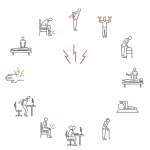Treat-to-target is a widely used approach for rheumatoid arthritis, in which rheumatologists prescribe treatments to reach established benchmarks of disease activity.1 Is it time for a similar approach for fibromyalgia treatment, even though its pathogenesis, disease-activity measures and treatment algorithms are less well understood? Three fibromyalgia researchers present their case in a new paper, “Treat-to-Target…
Search results for: psychosocial

ARHP Clinical Focus Course Targets Management of Adults with SLE
This year the ARHP Clinical Focus Course brings together experts in the field to provide an interprofessional approach to the management of systematic lupus erythematosus (SLE) to improve patient outcomes. The daylong course, titled Systemic Lupus Erythematosus: Taming the Wolf—Salient Lessons from Practice and Research, which is offered on Nov. 4, will provide a case-based…

Prospects for Treating Patients with Arthritis in African Countries with Few Rheumatologists
At present, the U.S. has approximately 5,000 full-time adult rheumatologists. By the year 2025, that number will decline to roughly 3,600.1 Sounds dire, right? Hold that thought. Question: What country has 99 million people and no adult rheumatologists? Answer: Ethiopia.2 The Nigerian Story And then there is Africa’s most populous country, Nigeria, with roughly 170…

Tips for Managing Young Adult Rheumatology Patients
Often, young adults (18–23 years old) with rheumatic illness demonstrate poor adherence to treatment regimens, lack advocacy skills and have inadequate knowledge about diagnosis and treatment.1 Patients presenting at a transition clinic are typically comfortable with having their parents continue to be centrally involved with their care, but this is a time in life when…

Rheumatologists Respond to Prescription Opioid Analgesic Crisis
The alarming statistics on prescription opioid overdoses are well known to medical professionals, thanks to the Centers for Disease Control and Prevention (CDC)’s widely cited finding that deaths from opioid analgesics have increased fourfold since 1999.1 Half of all fatal drug overdoses now involve opioids prescribed by a doctor. Meanwhile, a lack of rigorous research…

Rheumatologists, Social Workers Collaborate to Help Patients with Lupus
At the Hospital for Special Surgery (HSS), New York, rheumatologists and social workers have found that an interdisciplinary approach to care for systemic lupus erythematosus (SLE) patients improves the overall patient experience. “Our goal is to help patients navigate the complex healthcare system,” says Jillian Rose, LCSW, MPH, assistant director, Community Engagement, Diversity & Research….

Environmental Factors in Pediatric Systemic Autoimmune Diseases
Systemic autoimmune diseases are thought to result from immune dysregulation in genetically susceptible individuals who were exposed to environmental risk factors. Many studies have identified genetic risk factors for these diseases, but concordance rates among monozygotic twins are 25–40%, suggesting that nonheritable environmental factors play a more prominent role.1,2 Through carefully conducted epidemiologic and other…

New NICE Guidance for Low Back Pain
If left untreated, low back pain can cause long-term disability. To aid its diagnosis and management, the National Institute for Health and Care Excellence has released revised guidance. Recommendations include the use of risk stratification tools for diagnosis, as well as physical activity or a comprehensive program that addresses biomechanical, aerobic and/or psychological needs…

Pediatric Rheumatology Research Highlights Successful Approaches to Manage Juvenile Rheumatic Diseases
WASHINGTON, D.C.—Patients with juvenile rheumatic diseases are thriving in an era of highly effective therapies, successful self-management strategies, better understanding of genetic links to autoimmunity risk and improved efforts to listen to and engage with these young patients. That bright picture for young people with arthritis was presented by pediatrics at the ACR/ARHP Concurrent Abstract…
OIG Releases 2017 Work Plan: A Summary
Each fall, the Department of Health and Human Services (HHS) Office of Inspector General (OIG) puts out its Work Plan for the upcoming fiscal year to summarize its initiatives and priorities for new and ongoing work of HSS programs. Below is a summary of the key areas the OIG will focus on in 2017: Drug…
- « Previous Page
- 1
- …
- 8
- 9
- 10
- 11
- 12
- …
- 15
- Next Page »